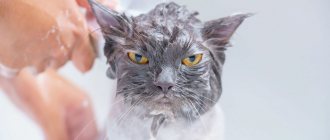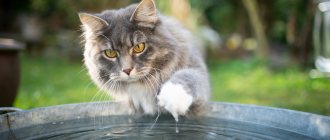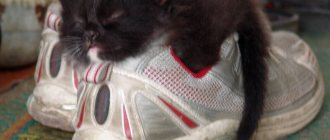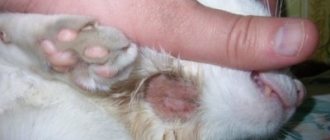Every cat owner's worst nightmare is bathing their furry friend. Unlike their larger felines (tigers, lions), which enjoy swimming in wild waters, small domestic cats do not seem to enjoy being near water. Oddly enough, we also often see cats curiously sticking their paws out to play with the flowing water from a faucet or fountain.
So what is the relationship between cats and water? Do cats have a phobia of being near water, or do they just hate showering like most of us do on rainy days?
While the whole cat-water relationship seems like a silly love-hate scenario, there is some interesting science behind cats' dislike of water.
Ancestors of cats
The origin and evolution of cats play a huge role in their behavior towards water. The earliest ancestors of domestic cats can be dated back to the Neolithic era (10,000 years ago).
During this era, in a region called the Fertile Crescent in the Middle East, our ancestors began experimenting with agriculture and farming. When they began to collect and store grain, rats and rodents came for their share. This is how the early ancestor of cats, Felis silvestris lybica (Steppe cat), appeared. These wild animals came closer to human settlements to hunt rats.
These cats helped keep rodents under control and proved worthy and valuable to humans. So when the first farmers began migrating from the Middle East to other parts of the world, they took their furry friends with them. So the cats began their global expedition.
In short, the ancestors of cats come from the Middle East and Egypt - places that are hot, arid and dry. The very first domesticated cats were desert animals that had little exposure to bodies of water. Therefore, naturally, their body was not adapted to being in water. This is the main reason why cats don't like water.
How Noah offended the cat and other legends
There is one interesting legend that explains this fear of hydrophobia. During the biblical Flood, Noah decided to build a huge ark, where he collected a pair of all earthly creatures in order to preserve them for future life, when the waters did subside. Before setting off in search of dry land, the elder warned all the birds and animals so that no one would quarrel with each other for the sake of preserving the species.
However, the devil (how could we live without him?) turned into a large toothy rat, entered the ark and began gnawing a hole in the bottom in order to drown everyone. The cat noticed this and, in turn, killed the rat.
Noah saw this massacre and became angry, because he warned that no one should attack anyone. Without understanding it, he ordered the cat to be thrown overboard into the raging waves. The comrades, however, quickly explained to the old man what had happened, showed the hole that the rat had gnawed, and returned the cat back. But since then she has had a persistent dislike for water.
However, another legend about the ark says that at first there were no cats on it at all, just like in the whole wide world. But during the voyage, all the wanderers were literally tormented by rats, and Noah asked the lion to start catching them. But he was too big to chase rats through all sorts of crevices and hiding places on the ark. Then the King of Beasts sneezed and, probably with assistance from above, a cat appeared on the deck of the ark. She started catching rats, but out of habit, she was also wary of the sea.
According to another legend, the cat appeared on the ark when Noah petted the lion.
Epic aside, it is believed that the modern domesticated pet is a descendant of African wild cats that lived in the desert and preferred not to settle near bodies of water. Therefore, they are traditionally unaccustomed to water.
However, there are ancient examples of other similar quadrupeds that were not deterred by water. For example, cats living on the shores of the Irish Sea have long been excellent swimmers and hunters in it. And the Siamese, according to legend, accompanied their dignitary mistresses while swimming in the pool.
And in general, some coastal peoples have a legend according to which a cat’s tail can bend in a characteristic way because it catches fish with it like a hook.
Cats, by the way, are excellent fish catchers if you train them to do so.
Physical factors
Some physical factors are one of the reasons why cats avoid contact with water.
High body temperature
Research shows that a cat's normal body temperature is between 36.7°C and 38.9°C, which is higher than that of a human. Since cats have a higher body temperature, their heat tolerance is also quite high. Thus, they generally prefer warmth and heat.
Even when domesticated, cats still have an innate predatory nature. They have an active metabolism and love to hunt. All of these activities require energy, which they obtain by conserving body heat or relying on external heat sources. This is why cats sunbathe or curl up in a ball... They know how to optimize their body heat.
Being in water, however, lowers their body temperature, which is not good for their health. Therefore, cats prefer to stay away from water.
Fur
You've probably seen dogs play with water and easily shake it off their fur, but cats can't do it. This is because their coats are completely different. A dog's fur is more like a raincoat, which sheds water easily, while a cat's fur is like wool, which gets wet and becomes heavier when wet.
A cat's fur can have two to three layers, depending on the cat's breed.
- Undercoat: An inner layer with short, fine hairs provides warmth and insulation.
- Guard Hair: The outer layer with longer hairs protects the undercoat.
- Austen coat: A layer of secondary hair between the undercoat and the guard hair.
Guard hairs versus undercoat: The longer ones are guard hairs and the shorter ones are undercoat hairs.
Cat fur is not waterproof, so when the cat is drenched in water, these layers become wet and lower the animal's body temperature.
If your cat has long hair, water will weigh it down; which makes it difficult for a cat to stay afloat and not drown. It will also affect their "cat reflexes" and make them feel uncomfortable. If the fur is shorter, exposure to water will make the cat very cold, which is also not good since their optimal temperature is warmer!
How to wash a cat if she is afraid of water
Photo: J. Triepke/Flickr
This is a serious undertaking that will require preparation, primarily psychological. You need to bathe a cat that is afraid of water in a state of mental balance. The owner’s nervous state will instantly be transmitted to the pet, and he may panic.
A cat that is afraid of water must be bathed indoors to prevent escape. The bathroom is best suited.
Everything necessary for washing (special cat shampoo and two towels for drying) must be prepared in advance and placed at arm's length. You need to remove the cap from the shampoo bottle in advance.
In any case, it is better to bathe your cat in a bathtub with an anti-slip mat on the bottom. The bath should be filled with water to the level of the cat's stomach, not higher. The temperature should be comfortable: within +38⁰ ... +40⁰. A cat that is afraid of water should not be watered with a shower head or ladle.
In general, the process of bathing a cat that is afraid of water differs from bathing a cat that is not afraid of it, only in speed. The cat should be taken to the bathroom when everything is ready. Then you need to quickly lower it into the bath, apply a drop of shampoo and quickly wash it over the body (the face and ears cannot be washed). Then you need to immediately rinse off the shampoo and immediately wrap the animal in the first towel.
After a few seconds, remove it and wrap the cat in a second towel. After this, you can leave the bathroom. It is advisable for the cat to dry in a warm room without drafts. It would be very nice to dry the cat with a hairdryer (especially if it is very fluffy), but not every cat, and even after such stress as bathing, will allow the hairdryer to be brought closer to itself.
Smell matters!
Cats have a sense of smell that is superior to humans. The average person has about 5 million receptors in their nose, while a cat has about 200 million.
Cats use scent to communicate, hunt, and detect predators. Cats even use the scent of their urine to mark their territory from other cats. According to research, smell is the primary method by which a cat analyzes its surroundings. Smell can make a cat feel either tense or secure in a certain environment.
Have you ever seen a cat grin strangely when it snorts? This is because, in addition to the nose, cats have another organ called the vomeronasal organ, located on the roof of their mouth. This organ is used when cats require a more in-depth scent analysis.
The Flehmen response in cats is to release scent into the vomeronasal organ, located at the top of the mouth.
Obviously cats are quite sensitive to smells, but what does this have to do with water? Actually, very big.
There are many chemicals and dissolved substances in water. And cats, with their sense of smell about 14 times better than humans, can detect most of them. This is one of the reasons why cats don't want water all over their bodies. They don't want unnecessary odors left on them! Just think about how strong the smell of chlorine in the water will be for our poor little cats.
In addition, cats rub against people, furniture, or other objects to transmit their scent. Therefore, water that gets on the fur can wash away this specific smell from the cat’s body, which it uses to determine its identity.
Water is stress
The cat begins to experience stress even before the bathing begins - when it is brought into the bathroom. The animal, with its excellent olfactory abilities, detects the smell of shampoo, with which it has had unpleasant sensations since the last bath; the murmur of water also does not cause delight in the cat - it understands what is about to happen to it and is frightened.
Advice! To at least partially calm the animal, wash it with special shampoos for cats without fragrance.
Owners are not very good at holding their pets under running water for the time necessary for a quality wash - some cats start hysterical even before the bath begins, others hold out for 2-5 minutes, and only a few patiently wait for the end of the unpleasant procedure.
The cat begins to feel stressed even before the bath begins.
But this does not mean that the most seasoned of animals are calm about bathing and water in general. Monitor the condition of your pet during washing: if he is pinched, his heart is pounding, calm the cat down, distract him with his favorite toy or favorite treat, so that the animal develops pleasant associations associated with bathing: after plunging into the water, something will definitely happen something interesting (game), or something tasty (meat).
If not water, then what?
Cats have made it clear that they don't need water to stay clean. In that case, how do cats keep themselves clean? The answer is... their language. Cats spend hours licking and grooming themselves. This does not happen out of boredom, but in order to keep their coat clean. A cat's tongue looks like a miniature comb. It has sharp, spine-like structures called papillae that help comb the fur and get rid of dirt. In addition, the saliva released during licking helps maintain body odor.
Close-up of a cat's tongue with papillae
Although most cat breeds are “hydrophobic,” there are exceptions. Some cat breeds love to be in water - this phenomenon is due to their evolution and body structure. Breeds such as the Turkish Van, Abyssinian, and some hybrid or trained breeds do not have problems with water and bathing.
Bengal cats, a hybrid breed, love to hunt on lakes
Now we have a clear idea why cats don't really like water. There are several strong historical, behavioral, and scientific reasons to support this common “aversion.” Their body, fur and sensory organs are not very adapted to water. Their curiosity at the sight of flowing water is due to their predatory nature. This causes them to check out the shiny liquid flowing in front of them. Cats are not afraid of water, they are just not used to it. So the next time your cat refuses to take a bath, try to remember that their ancestors were desert dwellers... and that your feline friend can probably take care of his own hygiene!
How to teach a cat to bathe
Cats wash themselves.
But sometimes additional bathing is required:
- The animal was very dirty - in paint, oil, etc.
- A performance at the exhibition is planned.
It is worth accustoming your pet to water in stages from an early age:
- Adaptation . Pour water into a bowl and place it in the middle of the room. Allow the cat to show interest in the subject on its own. Gently take the paws and wet them. Then wool. Don't insist if the cat resists. Praise, talk kindly. Repeat the procedure every day.
- Engagement . Turn bath time into a game. Throw some toys into the bathroom. The animal needs to get excited in the water and relax. Reward with a treat.
- Immersion . After you have developed a strong trust in water, proceed to washing your face. Calmly, carefully, slowly. Better with an assistant. Remember - you can’t get your head or ears wet.
Cats love to be clean and warm
Cats are meticulous about their natural cleanliness and spend much of their time grooming themselves, keeping their fur clean, untangled. Cats also maintain a higher body temperature, and brushing helps maintain and regulate it.
When a cat's fur gets wet, it becomes quite heavy and makes it difficult for her to quickly return to a dry, warm state. Wet fur can also make a cat feel slow and not as agile as usual, leading to the unpleasant feeling of being unable to quickly get out of a situation.
Cold and hot shower
When you take your pet in your arms, you always feel the warmth emanating from him. This is due to the fact that cats have a higher temperature than ours, and, therefore, the temperature of the water when bathing the animal must be made hotter than we are used to doing for ourselves. For a pet, this means washing in ice water. How many people do you know who will be grateful to you for a forced ice shower and will stand silently, not trying to escape? The skin receptors in a cat, like any other warm-blooded creature, perceive this as violence. And if they beat you, you have to run.
Cats don't really like the smell of perfume, especially if they start rubbing it into their fur. For small predators, such a fragrance is similar to the smell of fertilizers for us. Imagine if you started lathering your lady with something similar. It is unlikely that you would get away with scratches and a dissatisfied look.











